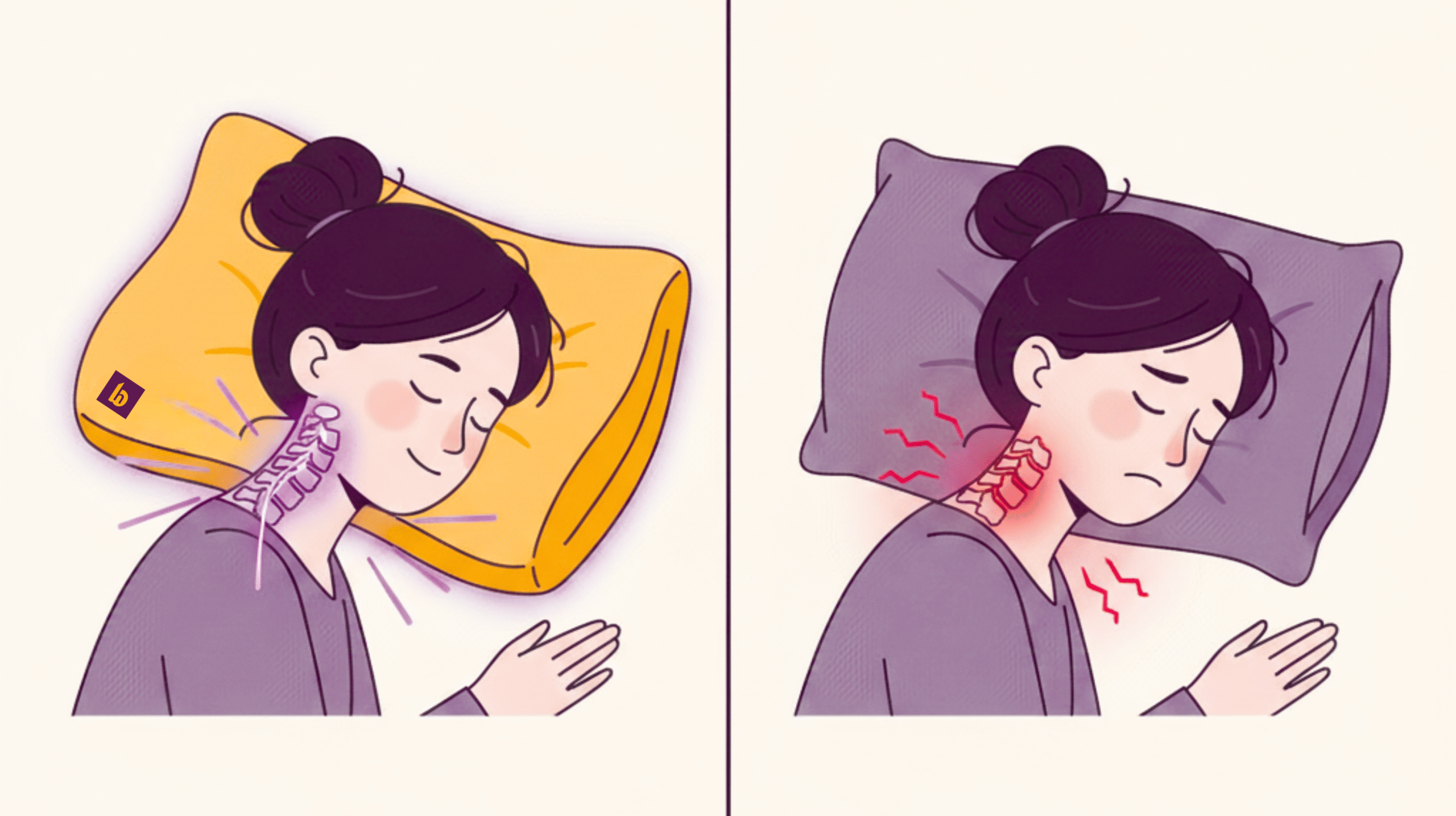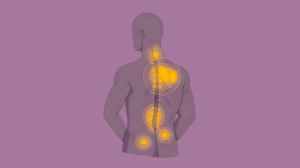Importance of Neck Support During
The quality of our sleep heavily depends on the support of our necks at night. When the neck is held in an ideal posture, the cervical spine remains in its natural position, which reduces pain and helps one sleep well. Misalignment due to lack of support may, on the other hand, result in stiffness, neck pain and difficulty sleeping.
Recent studies have demonstrated the significance of sleeping patterns and pillow choice in regard to the health of the neck [1]. For example, it has been found that the application of an inappropriate pillow support may elevate muscle activity and neck pain. Therefore, apart from the comfort factor, it is also necessary to choose the right pillow by considering spinal health.
Purpose of the Article
This article aims to study the intricate connection between the pillows and healthy necks. It covers the framework of the cervical spine, the impact of various sleeping positions on neck posture, and the ability of the right pillow to relieve neck pain and improve the quality of sleep. By the time you finish reading this article, you will have sufficient knowledge on pillows and sleep patterns to make informed decisions, which can eventually help your neck to become healthier.
Understanding Neck Anatomy and Sleep
Cervical Spine Structure
The cervical spine, commonly known as the neck, consists of seven vertebrae labeled C1 through C7. These vertebrae are stacked upon each other and are separated by intervertebral discs that act as shock absorbers. The cervical spine supports the weight of the head and allows for a wide range of motion, including nodding and rotation [2].
The first cervical vertebra, known as the atlas, supports the skull and allows for the nodding motion of the head. The second vertebra, the axis, enables the rotation of the head from side to side. Together, these two vertebrae facilitate the majority of head movements.
The remaining cervical vertebrae (C3–C7) contribute to the flexibility and stability of the neck. They house the spinal cord and nerves that transmit signals between the brain and the rest of the body. Proper alignment of these vertebrae is essential for maintaining nerve function and preventing pain.
How Does Sleep Affect Neck Posture?
Sleep posture plays a pivotal role in maintaining cervical spine alignment. The position in which we sleep can either support or strain the neck muscles and vertebrae.
- Back Sleeping: When sleeping on the back, it’s crucial to use a pillow that supports the natural curve of the neck. A pillow that is too high or too low can cause the neck to bend unnaturally, leading to discomfort.
- Side Sleeping: Side sleepers should use a firmer pillow that fills the gap between the neck and the mattress, ensuring that the head remains aligned with the spine.
- Stomach Sleeping: This position is generally not recommended as it can strain the neck due to the head being turned to one side for prolonged periods.
Research indicates that sleep posture is a significant factor in preventing neck and shoulder musculoskeletal pain. Proper alignment during sleep can reduce muscle activity and minimize pressure on the intervertebral discs, nerve roots, and facet joints [3].
Common Causes of Neck Pain
Neck pain is a prevalent issue that can arise from various factors:
- Poor Posture: Prolonged periods of improper alignment, such as slouching or forward head posture, can strain neck muscles, leading to discomfort.
- Muscle Strain and Tension: Overuse or sudden movements can cause muscles in the neck to become strained or tense, resulting in pain.
- Injuries and Whiplash: Trauma, such as from car accidents, can lead to injuries like whiplash, which affects the cervical spine and surrounding tissues.
- Degenerative Conditions: Conditions like osteoarthritis can cause the breakdown of cartilage in the cervical spine, leading to pain and stiffness [4].
- Sleeping Position: As discussed, improper pillow support or sleep posture can contribute to neck pain.

Addressing these factors through ergonomic adjustments, proper sleep habits, and appropriate pillow selection can significantly alleviate neck pain and improve overall quality of life
Are Pillows Beneficial for Neck Health?
Evidence-Based Research on Pillow Use
Scientific research has consistently highlighted the role of pillows in maintaining cervical spine alignment and reducing neck pain. A study demonstrated that participants using cervical pillows experienced significant reductions in neck discomfort compared to those using standard pillows [5]. The study measured muscle activity and range of motion, showing that proper pillow support helps muscles relax and reduces strain during sleep.
Pillow selection is crucial in preventing musculoskeletal pain, especially in individuals with preexisting neck or shoulder issues. Cervical and orthopedic pillows were noted to be particularly effective in maintaining spinal alignment and supporting proper sleep posture.
Benefits of Using a Suitable Pillow
A pillow that is appropriate for one’s sleep position and body type offers multiple benefits:
- Reduces Muscle Strain
- Proper cervical support ensures that neck muscles do not remain contracted during sleep.
- Reduces morning stiffness and tension headaches by minimizing overextension or flexion of neck muscles.
- Supports Spinal Alignment
- Aligns the head, neck, and shoulders, maintaining the natural lordotic curve of the cervical spine.
- Prevents rotational or lateral bending that can strain vertebrae or intervertebral discs.
- Enhances Sleep Quality
- Reduced discomfort and proper support allow for deeper, uninterrupted sleep cycles.
- Contributes to better overall health, as sleep quality directly affects immunity, cognitive function, and mood.
- Prevents Long-Term Damage
- Chronic poor sleep posture can contribute to degenerative changes in cervical vertebrae.
- Proper pillow support reduces risks of conditions such as cervical spondylosis or herniated discs.
Risks of Using an Improper Pillow
Using a pillow that is too soft, too firm, too high, or too low can have negative consequences:
- Increased Pain or Stiffness: Inappropriate support causes overextension or unnatural bending of the cervical spine.
- Poor Sleep Quality: Frequent waking due to discomfort reduces restorative sleep.
- Headaches and Fatigue: Misalignment can compress nerves or muscles, leading to tension headaches and fatigue.
Research suggests that even minor deviations in pillow height (more than 2–3 cm from ideal) can significantly impact neck alignment and musculoskeletal health [6].
Types of Pillows for Neck Support
Choosing the right pillow requires understanding the different types and how they interact with sleep positions and neck anatomy.
Memory Foam Pillows
Description:
Memory foam pillows are made from viscoelastic material that conforms to the shape of the head and neck, distributing pressure evenly.
Benefits:
- Adapts to the contours of the cervical spine.
- Reduces pressure points on the neck and shoulders.
- Provides consistent support without frequent adjustment.
Considerations:
- Retains heat, which may be uncomfortable for some sleepers.
- Initial chemical odor may be present (“off-gassing”) when new.
Best For:
Back and side sleepers who need firm but contouring support.
Orthopedic and Cervical Pillows
Description:
Orthopedic or cervical pillows are designed specifically to maintain the neck’s natural curve. Often contoured with raised and lowered areas, these pillows cradle the cervical spine.
Benefits:
- Therapeutic support for chronic neck pain or post-injury recovery.
- Promotes spinal alignment during sleep.
- Reduces morning stiffness.
Considerations:
- May feel too firm or unusual for first-time users.
- Limited adjustability unless paired with an adjustable base.
Best For:
Individuals with chronic neck pain, cervical spine injuries, or those recovering from surgery.
Water and Adjustable Pillows
Description:
Water pillows allow users to customize firmness by adding or removing water. Adjustable pillows often combine foam layers with removable inserts.
Benefits:
- Customizable height and firmness.
- Maintains consistent support as it adapts to head and neck movements.
Considerations:
- Requires maintenance to prevent leaks or uneven filling.
- Can be heavier or less portable than other types.
Best For:
Sleepers need adjustable support to optimize cervical alignment.
Latex Pillows
Description:
Latex pillows are made from natural or synthetic rubber foam. They are durable, resilient, and offer firm support.
Benefits:
- Maintains shape over time, offering consistent support.
- Hypoallergenic and resistant to dust mites and mold.
- Provides a firm feel while allowing some contouring.
Considerations:
- Can feel heavy or too firm for some sleepers.
- Typically more expensive than foam or fiberfill pillows.
Best For:
Back and side sleepers who prefer a natural, supportive pillow.
Feather/Down Pillows
Description:
Feather or down pillows are soft, lightweight, and can be molded to fit individual preferences.
Benefits:
- High comfort and softness.
- Easy to shape for short-term adjustments.
Considerations:
- Often lack firm support for cervical alignment.
- May flatten over time, reducing effectiveness.
- Can trigger allergies if not properly processed.
Best For:
Individuals seeking soft comfort, primarily back sleepers with minimal neck pain.
How to Choose the Right Pillow for Neck Health?
Selecting the correct pillow involves understanding your sleep position, pillow height, firmness, and material preferences. The goal is to maintain the natural cervical spine curve, minimize muscle strain, and improve sleep quality.
1. Sleep Position Considerations
Sleep position dramatically affects the type of pillow you should choose:
- Back Sleepers
- Recommended Pillow Type: Medium-loft memory foam or cervical pillow.
- Reasoning: A pillow with medium height fills the gap between the head and mattress, supporting the natural curvature of the neck. Too high a pillow can tilt the head forward, while too low can lead to hyperextension.
- Example: Memory foam pillow with a gentle contour for cervical support.
- Side Sleepers
- Recommended Pillow Type: Firmer, higher pillow to support the neck.
- Reasoning: The pillow should fill the space between the shoulder and head to prevent lateral bending of the cervical spine.
- Tip: Adjust pillow height based on shoulder width and body size.
- Stomach Sleepers
- Recommended Pillow Type: Thin, soft pillow or no pillow.
- Reasoning: Stomach sleeping often causes extreme cervical rotation. A thin pillow minimizes strain and reduces the risk of neck pain.
- Alternative: Gradually training to back or side sleeping is recommended for long-term spinal health.
2. Pillow Height and Firmness
- Pillow Height (Loft):
- High-loft pillows: >12 cm, suitable for side sleepers.
- Medium-loft pillows: 8-12 cm, suitable for back sleepers.
- Low-loft pillows: <8 cm, suitable for stomach sleepers.
- Firmness:
- Firm pillows provide strong support for side sleepers.
- Medium-firm pillows allow some contouring for back sleepers.
- Soft pillows are suitable for stomach sleepers but may not offer adequate support.
- Impact: Correct height and firmness prevent hyperflexion, hyperextension, and lateral bending of the neck, which are primary causes of neck pain.
Material Preferences
- Memory Foam: Contours to head and neck, relieves pressure points, and retains heat.
- Latex: Natural, firm, hypoallergenic, and maintains consistent support.
- Feather/Down: Soft, moldable, may require frequent fluffing, less supportive.
- Hybrid: Combines foam and fiberfill for balance between comfort and support.
- Water Pillows: Adjustable firmness, adapts to sleeping movements.
Tip: Allergies or heat retention should guide material choice. Memory foam and latex are ideal for support; water pillows for adjustability.
Signs a Pillow Isn’t Working
- Morning stiffness in neck or shoulders
- Persistent neck pain despite adequate sleep
- Headaches or fatigue upon waking
- Pillow flattened or compressed quickly
Replacing pillows every 1-3 years, depending on material, is generally recommended.
Tips for Optimal Neck Support While Sleeping
Maintaining neck alignment involves more than just choosing the right pillow. Placement, mattress support, and exercises play a crucial role.
1. Proper Pillow Placement
- Back Sleepers: Place the pillow under the neck, not just the head, to maintain cervical lordosis.
- Side Sleepers: Ensure the pillow fills the space between the ear and shoulder.
- Stomach Sleepers: Use a thin pillow or none to reduce neck rotation.
- Additional Tip: Avoid multiple stacked pillows; they can misalign the cervical spine.
Combining Pillow with Mattress Support
- Medium-Firm Mattress: Complements pillow support for spinal alignment.
- Too Soft Mattress: Head sinks too much, increasing cervical stress.
- Too Firm Mattress: Can push shoulders upward, misaligning neck.
The combination of mattress and pillow should keep the spine in neutral alignment from head to pelvis.
2. Neck Stretches and Exercises
Daily exercises can enhance pillow support and reduce tension:
- Chin Tucks: Sit or lie with head in neutral position; gently pull chin toward chest; hold 5 seconds; repeat 10 times.
- Neck Side Stretch: Tilt head to each side, holding 15-20 seconds.
- Shoulder Blade Squeeze: Retract shoulder blades together to relieve neck and upper back tension [7].
- Upper Trapezius Stretch: Gently tilt ear toward shoulder while applying light pressure with hand; hold 20 seconds.
Benefits:
- Reduces muscle tightness
- Improves posture
- Complements proper pillow support
3. Lifestyle Adjustments
- Posture Awareness: Correct posture during the day reduces strain at night.
- Screen Ergonomics: Adjust monitor height and seating to avoid forward head posture.
- Regular Breaks: Stretching during work prevents chronic neck tension.
- Sleep Hygiene: Maintain a consistent sleep schedule for optimal muscle recovery.
Case Examples
- Back Sleeper with Neck Pain:
- Using a memory foam pillow with cervical contour improved alignment and reduced morning stiffness after 2 weeks.
- Side Sleeper with Shoulder Discomfort:
- Switching to a high-loft latex pillow filled the shoulder gap, relieving neck and shoulder strain.
- Stomach Sleeper Transitioning:
- Training to side sleeping with a thin adjustable pillow reduced rotational stress and headaches.
Common Myths About Pillows and Neck Pain
There is widespread misinformation about pillows and neck health. Understanding the truth behind these myths can prevent further neck problems and improve sleep quality.
“Thicker Pillows Are Always Better”
Myth: Many believe that a thicker pillow provides better support.
Reality:
- Pillow thickness must correspond to sleep position and body size.
- Too thick a pillow causes the head to tilt forward or sideways, increasing cervical strain.
- Medium-loft pillows are often optimal for back sleepers, while side sleepers may need higher support depending on shoulder width.
Takeaway: Pillow height should maintain natural cervical curvature, not just fill space.
“Any Comfortable Pillow Is Fine”
Myth: Comfort alone ensures proper neck support.
Reality:
- Comfort is subjective and does not guarantee spinal alignment.
- A soft, comfortable pillow may fail to support the neck, leading to morning stiffness or chronic pain.
- Proper support must align the cervical spine, even if it feels firmer initially.
Takeaway: Choose pillows based on anatomical support, not just subjective comfort.
“Only Older Adults Need Cervical Pillows”
Myth: Neck-support pillows are only necessary for the elderly.
Reality:
- Neck pain can affect all age groups due to lifestyle, posture, and sleep habits.
- Cervical pillows help maintain alignment in younger adults, particularly those using computers or smartphones extensively [8].
- Early intervention with proper pillows can prevent long-term cervical degeneration.
When to Seek Medical Advice?
Even with the correct pillow and proper sleep hygiene, neck pain may indicate underlying medical conditions.
Warning Signs of Serious Neck Problems
Seek professional evaluation if you experience:
- Persistent neck pain lasting more than a few weeks
- Numbness or tingling in the arms or hands
- Weakness in upper limbs
- Sharp pain after trauma or injury
- Chronic headaches associated with neck stiffness
These symptoms may indicate herniated discs, cervical spondylosis, or nerve compression.
Role of Medical Professionals
- Physical Therapists: Recommend exercises, stretches, and ergonomic adjustments tailored to your condition.
- Orthopedic Specialists: Diagnose structural problems, prescribe treatments, and advise on cervical pillows or braces.
- Sleep Specialists: Evaluate sleep posture, mattress, and pillow compatibility for optimal support.
Tip: Combining medical advice with ergonomic interventions, proper pillow selection, and exercises produces the best outcomes.
Conclusion
Pillows play a critical role in neck health by maintaining spinal alignment, reducing muscle strain, and improving sleep quality. Proper pillow selection is a preventive measure and a therapeutic tool for individuals across all age groups, enhancing overall quality of life.
Pillows are necessary for better neck health, as they help to maintain the spine in a straight position, relax strained muscles and improve sleep. By having the right pillow, individuals of any age can enhance their overall quality of life.
However, only sleeping on the right pillow will not help if you don’t change your lifestyle. Refer to this for the same:
Frequently Asked Questions:
1. Can a pillow help relieve chronic neck pain?
Yes. Cervical, memory foam, or orthopedic pillows support proper alignment, reduce muscle strain, and relieve chronic pain when used consistently with good sleep posture.
2. What type of pillow is best for neck alignment?
Cervical or contoured memory foam pillows are ideal for most back and side sleepers. Adjustable or water-filled pillows allow customization based on individual needs.
3. How often should I replace my pillow for neck health?
Replace pillows every 1–3 years, depending on material, wear, and support. Memory foam and latex pillows may last longer, while feather or down pillows compress faster.
4. Are memory foam pillows better for neck support?
Memory foam pillows conform to the cervical curve, relieve pressure points, and maintain alignment. They are often superior for side and back sleepers.
5. Can the wrong pillow cause headaches?
Yes. Improper pillow height or lack of cervical support can strain neck muscles and nerves, leading to tension headaches or migraines.
References
- Daryushi, S., Allahyari, T., & Karimi, Z. (2025). The Influence of Pillow Shape and Content on Neck Muscular Activity and Perceived Comfort. The Open Public Health Journal, 18(1). DOI: 10.2174/0118749445371712250130065843
- Kang, Y. H. (2001). Anatomy and Physiology of Lumbar Spine. Journal of Korean Society of Spine Surgery, 8(3), 264-273. DOI: https://doi.org/10.4184/jkss.2001.8.3.264
- Lee, W. H., & Ko, M. S. (2017). Effect of sleep posture on neck muscle activity. Journal of physical therapy science, 29(6), 1021-1024. DOI: 10.1589/jpts.29.1021
- Gellhorn, A. C., Katz, J. N., & Suri, P. (2013). Osteoarthritis of the spine: the facet joints. Nature Reviews Rheumatology, 9(4), 216-224. DOI: https://doi.org/10.1038/nrrheum.2012.199
- Fazli, F., Farahmand, B., Azadinia, F., & Amiri, A. (2019). The effect of ergonomic latex pillow on head and neck posture and muscle endurance in patients with cervical spondylosis: a randomized controlled trial. Journal of Chiropractic Medicine, 18(3), 155-162. https://doi.org/10.1016/j.jcm.2019.02.003
- Lei, J. X., Yang, P. F., Yang, A. L., Gong, Y. F., Shang, P., & Yuan, X. C. (2021, October). Ergonomic consideration in pillow height determinants and evaluation. In Healthcare (Vol. 9, No. 10, p. 1333). MDPI. https://doi.org/10.3390/healthcare9101333
- Andersen, L. L., Jørgensen, M. B., Blangsted, A. K., Pedersen, M. T., Hansen, E. A., & Sjøgaard, G. (2008). A randomized controlled intervention trial to relieve and prevent neck/shoulder pain. Medicine & Science in Sports & Exercise, 40(6), 983-990. DOI: 10.1249/MSS.0b013e3181676640
- Moon, K. A., Kim, J. H., Kim, Y. J., Park, J. H., & Jeon, H. S. (2024). A comparative study on the effects of three types of pillows on head-neck pressure distribution and cervical spine alignment. Phys Ther Korea, 31(1), 8-17. https://doi.org/10.12674/ptk.2024.31.1.8























